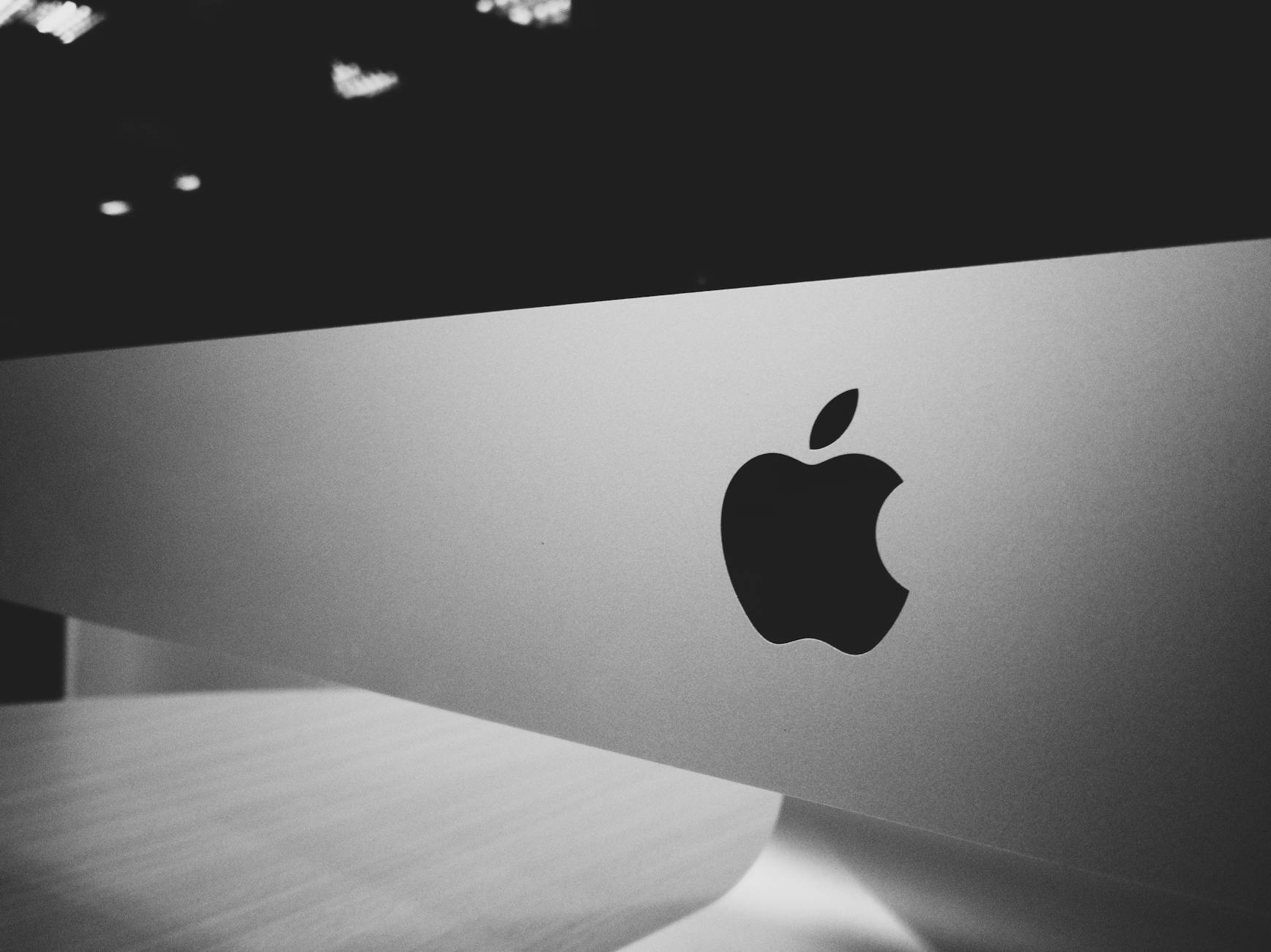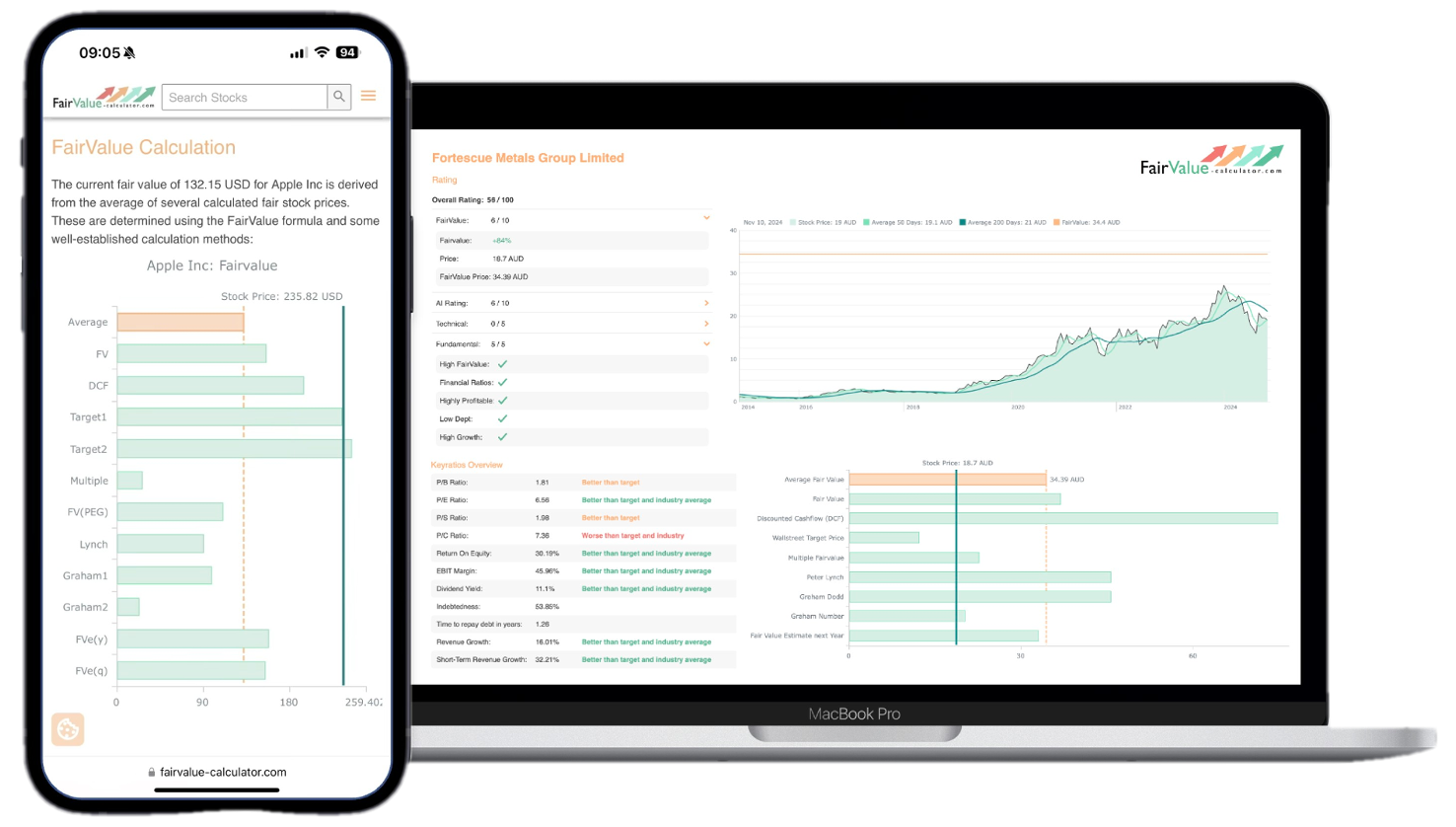When Apple unveiled its newest venture, “Answers,” it wasn’t just another tech announcement. Echoing throughout the halls of innovation, this move signifies Apple’s foray into a privacy-centric AI assistant designed to redefine how personal devices operate. Unlike conventional AI, “Answers” is set to run directly on your iPhone 16, championing the cause of speed and privacy without reliance on cloud processing. While it’s not competing directly with full-scale platforms like ChatGPT, its seamless integration within Apple’s ecosystem promises a novel user experience. Yet, as intriguing as this development is, it raises a critical question: what does this mean for Apple’s stock valuation?
💡 Discover Powerful Investing Tools
Stop guessing – start investing with confidence. Our Fair Value Stock Calculators help you uncover hidden value in stocks using time-tested methods like Discounted Cash Flow (DCF), Benjamin Graham’s valuation principles, Peter Lynch’s PEG ratio, and our own AI-powered Super Fair Value formula. Designed for clarity, speed, and precision, these tools turn complex valuation models into simple, actionable insights – even for beginners.
Learn More About the Tools →
Despite the buzz surrounding Apple’s AI prowess, the numbers tell a different story. Currently priced at $202.38, Apple’s stock appears significantly overvalued with a fair value estimate standing at $122.90—indicating a whopping 39% overvaluation. This conundrum deepens when you consider that while the AI rating is a robust 9/10, both technical and fundamental ratings are worryingly low at 1/5. This discrepancy highlights a pressing concern: can the enthusiasm around Apple AI truly justify such a high market multiple, or are investors caught in a valuation trap? As we delve deeper, we’ll explore whether Apple’s bold leap into AI can align its market value with its technological ambitions.
🚀 Test the Fair Value Calculator Now!
Find out in seconds whether your stock is truly undervalued or overpriced – based on fundamentals and future growth.
Try it for Free →
Do you think Apple’s AI is better than everyone else’s AI?
When evaluating whether apple ai outpaces rival systems, it helps to define “better.” If your criteria are raw generative power, ChatGPT-like conversation depth, or open-ended research assistance, full-scale AI platforms currently hold the lead. They train on colossal datasets, leverage massive GPU clusters, and deliver nuanced, extensive text generation. In contrast, Apple’s “Answers” is deliberately lightweight. It prioritizes on-device speed, ultra-low latency, and strict privacy compliance over broad knowledge synthesis. In pure capability tests, like code generation, academic tutoring, or extended creative writing, ChatGPT, Gemini, and Bing AI still win hands down.
However, if “better” means seamless integration into daily workflows, near-instant responses without waiting for a cloud round-trip, and end-to-end data control, Answers may feel superior. On an iPhone 16, minimalist prompts yield rapid, relevant results, tightly linked to your apps, contacts, and calendar, without Apple ever seeing your data. For millions of Apple loyalists, that frictionless privacy-first assistant could be a more valuable tool than a more powerful but remote AI engine. Ultimately, whether Apple’s approach is “better” depends on use case. For privacy and integration, it’s a leap forward; for unbounded creative depth, it still trails the specialized leaders.
Explore our most popular stock fair value calculators to find opportunities where the market price is lower than the true value.
- Peter Lynch Fair Value – Combines growth with valuation using the PEG ratio. A favorite among growth investors.
- Buffett Intrinsic Value Calculator – Based on Warren Buffett’s long-term DCF approach to determine business value.
- Buffett Fair Value Model – Simplified version of his logic with margin of safety baked in.
- Graham & Dodd Fair Value – Uses conservative earnings-based valuation from classic value investing theory.
- Intrinsic vs. Extrinsic Value – Learn the core difference between what a company’s really worth and what others pay.
- Intrinsic Value Calculator – A general tool to estimate the true value of a stock, based on earnings potential.
- Fama-French Model – For advanced users: Quantifies expected return using size, value and market risk.
- Discount Rate Calculator – Helps estimate the proper rate to use in any DCF-based valuation model.
Do you believe that Apple has built AI with privacy at the core? Why or why not?
Apple’s track record on privacy is well-established: differential privacy in analytics, on-device face recognition, and app-tracking transparency set industry benchmarks. With Answers, Apple doubles down by embedding inference models directly into the iPhone 16’s silicon. The entire processing pipeline—text parsing, intent detection, and response generation—occurs offline. No user queries are uploaded to servers, and personal data remains encrypted at rest. This design is a purposeful departure from cloud-centric AI. By minimizing external data transfers, Apple significantly reduces exposure to breaches or surveillance, reinforcing its “privacy at the core” narrative.
Yet, skeptics note that true privacy extends beyond inference. Continuous model updates, diagnostic telemetry, and error reporting sometimes rely on aggregated cloud feedback. While Apple anonymizes and limits these streams, there remains a semblance of cloud interaction—albeit far slimmer than competitors’. Moreover, some advanced use cases (real-time language translation between two distant devices) might require server assistance. Overall, Apple has unquestionably prioritized user confidentiality in its apple ai strategy; the residual cloud touches are pragmatic trade-offs rather than privacy oversights.
Is Apple falling behind in AI or being smart by waiting?
Compared to early movers like OpenAI, Google Brain, and Meta AI, Apple’s timeline seems conservative. While ChatGPT began public trials in late 2022 and Google rapidly followed with Gemini in 2023, Apple only previewed “Answers” in mid-2025. By some measures, that’s playing catch-up. Yet, early entrants encountered scrutiny over hallucinations, data leaks, and unaddressed biases. Apple’s delayed entry allowed it to observe these pitfalls and refine a model architecture optimized for trustworthiness.
Rather than racing to release scalable but potentially risky AI, Apple appears to have focused on silicon-software co-design. By waiting for the A18/M4 chips in the iPhone 16, they ensure on-device inference is both fast and energy-efficient. This patience may cost them short-term hype but pays dividends in user satisfaction and brand integrity. In a market increasingly sensitive to data misuse, a privacy-first, polished solution might ultimately win more loyal users than a feature-rich but flawed competitor.
What are your thoughts on Apple’s intelligence?
“Apple Intelligence” feels less like a buzzword and more like a philosophy. Where “AI” conjures images of massive data centers and endless server chalkboards, “Intelligence” evokes a discreet, seamless layer woven into everyday life. It’s about context, anticipation, and frictionless aid, qualities Siri has marginally delivered for years. With advances in language understanding, image analysis, and contextual awareness, Apple Intelligence aims at preemptively surfacing relevant info. Imagine your iPhone summarizing your board meeting minutes before your coffee or suggesting travel packing lists based on incoming itinerary emails.
The success of this vision hinges on user trust. By embedding critical routines, text completion, photo search, email drafting, under the Apple Intelligence umbrella, the company bets that convenience plus privacy will foster deep adoption. For many retail investors, that sounds promising: a sophisticated assistant without the headache of data exposure leverages Apple’s ecosystem strengths. But until widespread public feedback arrives, we remain watchers, curious whether the reality matches the marketing promise.
Is Apple behind on AI? Can it keep up or catch up?
On raw model power, Apple trails the multi-billion-parameter giants. Those models are trained on internet-scale datasets using thousands of GPUs. Apple’s on-device approach is orders of magnitude smaller by design. However, catch-up isn’t purely about parameter count. It’s about delivering responsible, context-aware intelligence without compromising privacy. Integrating advanced neural networks with specialized hardware accelerators—like the Neural Engine—gives Apple a unique edge in energy efficiency and latency.
Looking ahead, Apple can close the capability gap by leveraging federated learning, on-device personalization, and optimized compiler toolchains to squeeze more performance from limited compute. They may partner with research labs or license specialized models to bolster niche domains (medical, legal). If Apple successfully balances performance with privacy, it can narrow the feature gap without racing in the same league as cloud hyperscalers. In short, they might not match ChatGPT word-for-word, but they can deliver a compelling, trust-based alternative tailored to billions of iPhone users.
What is Apple Intelligence and why isn’t it called Apple AI?
Terminology matters—especially in marketing. “AI” often triggers mental images of opaque server farms and data mining. By choosing “Apple Intelligence,” the company reframes its tech as an extension of human cognition rather than a black-box algorithm. Intelligence suggests contextual awareness, learning over time, and sensitivity to user needs, aligning closely with Apple’s brand ethos of intuitive design.
Moreover, “Apple AI” could clash with regulatory scrutiny. Governments scrutinize “AI” in banking, healthcare, and education for bias or errors. “Intelligence” sounds less speculative and more practical—like a smart assistant, not a sentient system. This linguistic nuance helps Apple sidestep some negative connotations while emphasizing that its models are tools, not oracles.
What is Apple Intelligence?
At its core, Apple Intelligence is a suite of machine learning features baked directly into iOS, iPadOS, and macOS. It encompasses conversational assistance (via Answers), enhanced Siri capabilities, image analysis (live text, object recognition), and predictive routines (app suggestions, keyboard autocorrect). Instead of isolated “AI labs,” these features live across system services, Messaging, Photos, Mail, and Notes, making them feel like fundamental OS enhancements rather than add-ons.
Key tenets include on-device processing, minimal cloud dependencies, and deep hardware optimization. This ensures user data, photos, messages, personal calendars, never leaves the device in raw form. Updates to models occur through encrypted app or OS updates, not continuous telemetry. For the end user, Apple Intelligence should simply “work” in the background: a silent partner that refines your daily tasks with each interaction, without demanding constant configuration or data sharing permissions.
Overview of Apple’s “Answers” AI Venture
Mark Gurman’s August 3, 2025 Bloomberg report revealed “Answers,” a new internal AI department focused on lightweight, privacy-first on-device assistants. Unlike Siri’s cloud-centric model, Answers runs inference on the iPhone 16’s Neural Engine, delivering sub-second responses for queries spanning weather forecasts to email summaries. This marks Apple’s first venture into dedicated large language models in a consumer device.
The strategic intent is clear: differentiate from ChatGPT-style services by owning the entire stack, hardware, OS, and model. By tightly integrating Answers into the system, Apple can optimize battery, performance, and data security. Initial demos show promise: complex prompts handled privately and offline, with fallback cloud support only for edge cases. Answers isn’t a direct ChatGPT rival; it’s a curated, context-rich companion grounded in user privacy.
The Impact of “Answers” on Personal Device Functionality
Answers transforms an iPhone from a passive tool into a proactive assistant. Everyday tasks, drafting replies, generating photo captions, summarizing articles, become instantaneous. With on-device inference, latency drops dramatically; no more spinning wheels waiting for cloud calls. This responsiveness enhances productivity, especially for users in low-connectivity areas or privacy-sensitive contexts.
Beyond speed, Answers unlocks new use cases: offline travel translations, voice-to-text note-taking in secure environments, and local document searches with natural-language queries. As Apple refines model capabilities, we may see AI-assisted photo editing, contextual calendar suggestions, and email triage, all executed without sending data to external servers. For users, this yields both convenience and peace of mind.
A Comparison Between “Answers” and Full-Scale AI Platforms
Full-scale platforms like ChatGPT and Gemini excel at deep reasoning, creative storytelling, and multi-turn dialogues across diverse topics. They leverage extensive cloud resources, continuous model retraining, and vast knowledge bases. In contrast, Answers is scoped for relevance over breadth: it accesses local data, personal context, and selected knowledge graphs to keep responses concise and private.
This specialization yields trade-offs. Answers may occasionally decline out-of-scope prompts or offer shorter replies. But it wins on responsiveness, reliability, and data governance. For users wanting broad web research or developer API integrations, server-based AI remains superior. Yet for daily, personal workflows—drafting emails, finding files, summarizing notes—Answers may feel more intuitive, secure, and integrated than a generic cloud assistant.
Integration of “Answers” within Apple’s Ecosystem
Unlike standalone apps, Answers is woven into core system services. In Mail, it can draft responses; in Notes, summarize bullet points; in Photos, suggest keywords. Universal Clipboard syncs prompts from Mac to iPhone, retaining full privacy safeguards. Apple Watch and AirPods may soon gain slimmed-down versions, enabling quick voice queries without iPhone proximity.
This ecosystem synergy is Apple’s secret sauce. By controlling hardware and software, they ensure Answers feels like a native layer rather than a tacked-on feature. Cross-device continuity means your prompts, snippets, and preferences remain local to your Apple ID, encrypted end-to-end, and available wherever you work—strengthening lock-in and raising switching costs.
Analyzing Apple’s Stock Valuation: Current Price vs. Fair Value Estimate
Apple’s new AI initiative has injected fresh enthusiasm into the stock, but does the price reflect reality? As of mid-2025:
- Current Price: $202.38
- Fair Value Estimate: $122.90
- Implied Overvaluation: 39% above fair value
- AI Rating: 9/10
- Technical Rating: 1/5
- Fundamental Rating: 1/5
This breakdown shows investors are pricing significant optionality around apple ai and the broader intelligence strategy, even though near-term revenue impact and traditional fundamentals remain muted. The question becomes whether Apple’s innovation pipeline and pricing power can justify a rerating back toward a premium multiple—or if current enthusiasm is a near-term mirage.
Technical and Fundamental Ratings of Apple Stock
Despite a sky-high AI rating, Apple’s technical and fundamental scores lag severely. A 1/5 technical rating signals bearish momentum indicators: weakening moving-average crossovers, relative strength index (RSI) stuck below neutral, and low trading volumes. These metrics suggest institutional investors may be trimming positions, pressuring the share price even as headlines dazzle.
On the fundamentals side, Apple’s 1/5 rating reflects slowing revenue growth in key segments (iPhone unit sales trending flat), margin compression in services, and an elevated P/E multiple near 25x forward earnings. While R&D investment into apple ai and silicon design is ramping, meaningful top-line contributions from “Answers” are still years away. To justify current valuation, Apple must translate these AI capabilities into new subscription services, higher hardware ASPs, or licensing opportunities, none of which are baked into Q3 2025 results yet.
Ultimately, the high AI rating reveals investor optimism on transformative potential. The low technical and fundamental scores underscore the risk in that optimism. Retail investors should weigh both before adding to their apple ai-themed positions.
Conclusion: Navigating the Apple AI Revolution as an Investor
Apple’s shift into privacy-first on-device AI, branded as “Answers” under the umbrella of Apple Intelligence, marks a meaningful evolution in the company’s long-standing emphasis on user confidentiality. While the technology shows promise, the current stock price at $202.38 implies a best-case scenario for rapid commercial payoffs that may take years to materialize.
With a fair value estimate of $122.90 (–39% from the market price), low technical and fundamental ratings, but a strong 9/10 AI score, investors must decide if the apple ai wave justifies a premium multiple. For those curious about fair valuations across thousands of stocks, visit fairvalue-calculator.com to explore over 10,000 ticker analyses and refine your portfolio strategy.







